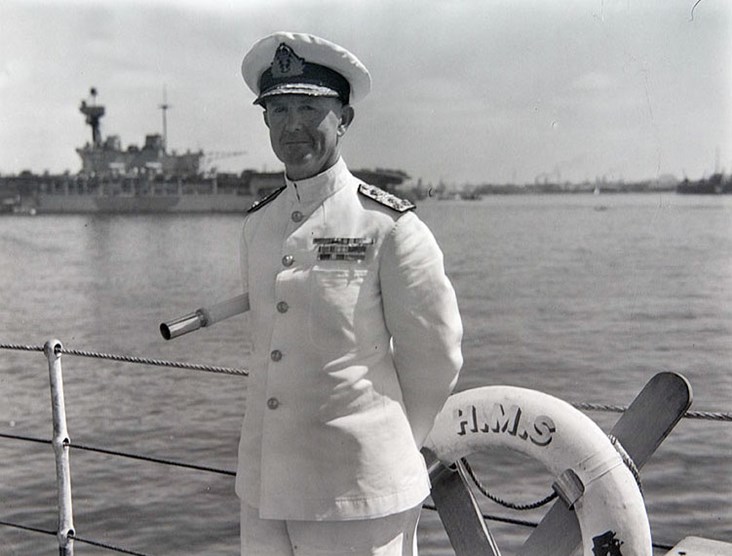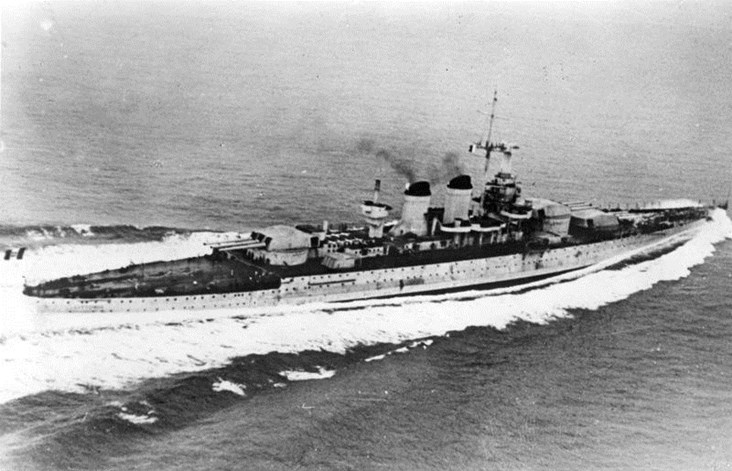Taranto Was Indeed a 'Glorious Episode'
A 'Crippling Blow' Struck at Italy's Fleet
The War Illustrated, Volume 3, No. 65, Page 563-564, November 29, 1940.
"If they won't come out of Taranto", Admiral Cunningham is reported to have declared, "we shall blast then out". That, indeed, is what the Royal Navy did on November 11, when the ‘planes of the Fleet Air Arm bombed Italy's warships in Taranto harbour and in a few minutes put three battleships out of action.
When Mr. Churchill rose from his seat in the House of Commons on the afternoon of November 13 everyone could see that he was bubbling over with excitement. When he began to read his speech – carefully prepared as always – he read so fast that he left the reporters in the Press Gallery gasping. But very soon he was halted by the storm of cheering. "I have some news for the House", he announced. "It is good news. The Royal Navy has struck a crippling blow on the Italian Fleet."
When the cheering had died down, the Premier proceeded to tell of a truly "glorious episode". He began by reminding the House that the Italians had possessed a battle fleet of six battleships – two of the Littorio class which had been put into service only lately and were, of course, among the most powerful vessels in the world, and four of the recently-reconstructed Cavour class. This fleet was considerably more powerful, on paper, than our Mediterranean Fleet, but it had consistently refused to accept battle. Then, with beaming face, Mr. Churchill announced that "on the night of November 11-12, when the main units of the Italian Fleet were lying behind their shore defences in their naval base at Taranto, our aircraft of the Fleet Air Arm attacked them in their stronghold.
"The reports of our airmen", he went on, "have been confirmed by photographic reconnaissance. It is now established that one battleship of the Littorio class is so badly down by the bows that her forecastle is under water, and she has a heavy list to starboard. One battleship of the Cavour class has been beached, and her stern, up to and including the after turret, is under water. This ship is also heavily listed to starboard. It has not yet been possible to establish the fact with certainly, but it appears probable that a second battleship of the Cavour class has also been severely damaged and beached. In the inner harbour of Taranto two Italian cruisers are listed to starboard and are surrounded by oil fuel, and two Fleet auxiliaries are lying with their sterns under water."
Continuing his statement, the Premier recalled that the Italian communiqué of November 12, while admitting that one warship had been severely damaged, claimed that six of the attacking aircraft had been destroyed and probably three more shot down. In fact, however, only two British aircraft were missing, and even of these some of the crew had apparently been taken prisoner.
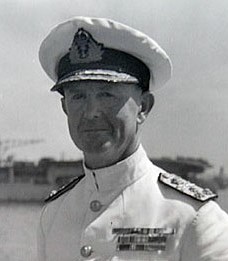 Above is Admiral Sir Andrew Cunningham, Commander-in-Chief in the Mediterranean since 1939, who, after Taranto, was described by the First Lord of the Admiralty as "a gallant and skilful C.-in-C." Photo, British Official; Crown Copyright.
Above is Admiral Sir Andrew Cunningham, Commander-in-Chief in the Mediterranean since 1939, who, after Taranto, was described by the First Lord of the Admiralty as "a gallant and skilful C.-in-C." Photo, British Official; Crown Copyright.
"As a result of a determined and highly successful attack", he concluded, "which reflects the greatest honour on the Fleet Air Arm, only three of the Italian battleships remain effective. This result, while it affects decisively the balance of naval power in the Mediterranean, also carries with it reactions upon the naval situation in other quarters of the globe."
Further details of the gallant and extraordinarily successful action were given later in the evening by the First Lord of the Admiralty, Mr. A. V. Alexander, in the course of a postscript to the nine o'clock news. He began with the reminder that when broadcasting on November 2 he had said that the Italian Admiralty regarded their capital ships as a capital investment and appeared determined to emerge from the war with their capital intact. "Today, I may be permitted to say we have imposed a severe capital levy on the Italian Navy."
Until the action at Taranto, the First Lord went on, our battle fleet in the Mediterranean was smaller in number than Italy's, but for reasons best known to themselves the Italians did not seek to exploit their superiority. They carefully avoided the action which Admiral Cunningham, Commander-in-Chief of the British Fleet in the Mediterranean, has always sought, and remained immobile behind the defences of their harbour. But in the event even these have failed to protect them. Within their inglorious shelter the Italian Fleet suffered on that November night a defeat which could have been redeemed in the public mind only had it shown itself willing to accept battle at sea. Now their numerical superiority has been reduced to inferiority in an action in which the dispositions of their admirals only allowed them to offer passive defence."
When the attack at Taranto was launched it was bright moonlight, and the ‘planes of the Fleet Air Arm had to face strong anti-aircraft defences, supplemented by a balloon barrage.
Italian Naval Losses, June 11 – Nov. 11, 1940
At Taranto
Two battleships (1 Cavour and 1 Littorio class) made ineffective.
One battleship (Cavour class) severely damaged.
Two cruisers heavily damaged and out of action; two Fleet auxiliaries damaged.
Earlier losses
"Bartolomeo Colleoni", cruiser, 5,000 tons, sunk by H.M.A.S. "Sydney" on July 19.
"San Giorgio", an old cruiser of 9,232 tons, heavily damaged and beached in a Fleet Air Arm attack on Tobruk on June 11. Probably a total loss.
Nine destroyers and several sea-going torpedo boats and motor torpedo boats have been sunk.
Submarine "Galileo Galilei" captured by H.M. trawler "Moonstone".
There should have been 21 ‘planes – eleven carrying torpedoes and ten loaded with bombs and flares – but one bomber was delayed and another developed tank trouble and had to return. As soon as they appeared above their targets, the first wave of bombers dropped flares to illumine the path of the torpedo-carriers. With their engines roaring at full blast and with the wind screaming through their wires, these flew from 8,000 feet down to 5,000 feet, and then in a silent glide to 50 or even 20 feet above the water, when they fired their torpedoes. Nine torpedoes are known to have reached their marks; the other two may have done so, but the ‘planes which carried them failed to return. After the torpedo-carriers had risen again into the air bomber No. 9 made its appearance – late, but not too late, for though all the fire of the ground defences and the ships' guns was concentrated upon it, it attacked the cruisers lying in the inner harbour with excellent effect.
Probably the attack lasted only a few minutes, but those few minutes were sufficient to wipe out Italy's superiority in capital ships, and to make it more than ever impossible for Mussolini to substantiate his frequent boast that the Mediterranean is Italy's sea.
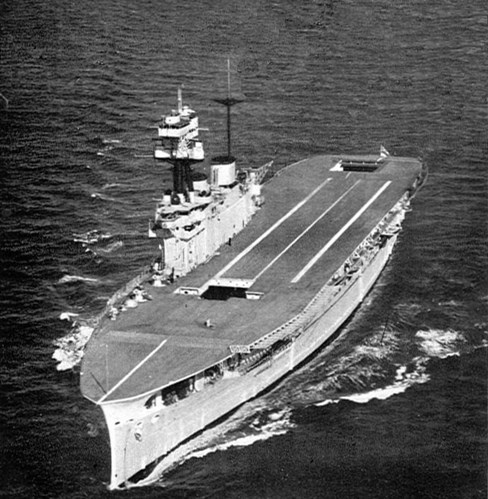 At the outbreak of the last war H.M.S. "Eagle", one of the two aircraft carriers which made the attack on Taranto, was being built as a battleship for the Chilean Navy, but in 1917 she was bought by the British Government and completed as an aircraft carrier. She has a displacement of 22,600 tons, and a speed of 24 knots, while she carriers normally 21 aircraft and a complement of 778. Photo, Charles E. Brown.
At the outbreak of the last war H.M.S. "Eagle", one of the two aircraft carriers which made the attack on Taranto, was being built as a battleship for the Chilean Navy, but in 1917 she was bought by the British Government and completed as an aircraft carrier. She has a displacement of 22,600 tons, and a speed of 24 knots, while she carriers normally 21 aircraft and a complement of 778. Photo, Charles E. Brown.
The action at Taranto, declared Mr. Alexander, would help not only Britain's declared friends but free people everywhere. "It is a blow struck in full support of our gallant Greek ally, whose successful attacks on their treacherous enemy have thrilled us all. It will hearten them in proportion as it must depress the boastful and opportunist Mussolini, who, having waited to enter the war until he thought he was sure of the spoils of victory without fighting, now must see the writing on the wall and know that he is going to be beaten."
Concluding his broadcast, the First Lord paid tribute to the courage and skill of he Fleet Air Arm pilots, and of the Fleet Air Arm as a whole – that Arm which, off the Norwegian coast, in the British Channel and the Mediterranean, have destroyed at least 55 enemy aircraft, severely damaged at least an equal number, and sunk or damaged numbers of enemy warships and auxiliaries. "They are, indeed, worthy comrades of the pilots of the R.A.F." Then he proceeded to mention, in particular, the gallant and skilful Commander-in-Chief, Admiral Sir Andrew Cunningham, and Rear-Admiral Lyster, whose inspiring leadership of the Fleet Air Arm has been backed by Captain Bridge and Captain Boyd of the aircraft carriers, "Eagle" and "Illustrious". (This mention of the "Illustrious", by the way, was the first public intimation of the completion of this newest of the Navy's aircraft carriers; the "Eagle" is one of the oldest, and it seems most peculiarly appropriate that these two ships should have collaborated in one of the most successful operations of the war to date.)
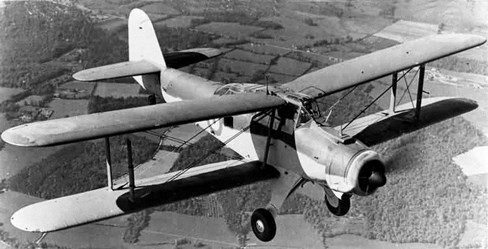 Among the several types of 'planes used by the Fleet Air Arm is the Fairey Albacore biplane, one of which is seen above. It is designed for torpedo-carrying, spotting and reconnaissance, and machines of this type might have been employed in the attack on Taranto. It is powered with a Bristol Taurus sleeve-valve engine of over 1,000 h.p., and has an exceptional performance, but details of its speed and range and of its armament have not yet been disclosed. Photo, Fox.
Among the several types of 'planes used by the Fleet Air Arm is the Fairey Albacore biplane, one of which is seen above. It is designed for torpedo-carrying, spotting and reconnaissance, and machines of this type might have been employed in the attack on Taranto. It is powered with a Bristol Taurus sleeve-valve engine of over 1,000 h.p., and has an exceptional performance, but details of its speed and range and of its armament have not yet been disclosed. Photo, Fox.
Not only at Taranto did the Navy strike at Mussolini. On the same night a squadron of our light forces operating on the main line of Italian communications with Albania, across the Straits of Otranto, intercepted off the Albanian port of Valona an enemy convoy consisting of four supply ships escorted by two destroyers. "Of the enemy supply ships", stated the Admiralty communiqué issued on November 13, "one was sunk outright, two were set seriously on fire, and almost certainly sank. The fourth was damaged, but succeeded in escaping under cover of a smoke screen. Both the escorting destroyers escaped at high speed under cover of smoke, but one of them was hit and damaged. No damage or casualties were sustained by our forces."
Still we have not finished the tale of victory. On that same Armistice Day 13 Italian aeroplanes paid for their temerity in raiding Britain, the majority of them being shot down before they managed to cross the coast. All in all, then, it was a black week for the Italians – the week which saw their defeat at Gallabat, the destruction of some of their crack troops in Greece, the bombing of their bases in Albania and Italy, and as its climax, Taranto. These, said Mr. Alexander, are "blows inflicted upon each and every arm of the Italian forces."
Index
Previous article
The Glory of Taranto: The Courage of Coventry
'If they won't come out, we'll blast them out' - Cunningham
Next article
Mussolini's Battleships Were Not Safe in Taranto
In the Fleet Air Arm's attack on Taranto on November 11, 1940 a ship of the Littorio class was left with her forecastle under water and a heavy list. Above is the "Littorio", one of four capital shi

